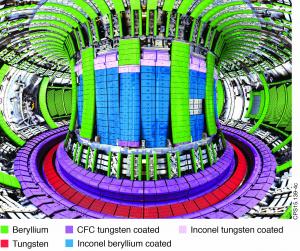The invitation came from EUROfusion, the European Consortium for the Development of Fusion Energy. What has already been coined as "JET internationalization" covers a number of aspects in support of ITER: saving ITER time, using JET as a test rig and training ground for ITER in order to help the project start off with the right foot in 2025.
JET's assets speak for themselves: the machine is currently the largest operating tokamak in the world and also the only one capable of carrying out experiments using deuterium-tritium (DT) fuel. In addition, JET is equipped with an ITER-like plasma-facing wall, a tungsten divertor and beryllium wall, tritium and beryllium handling facilities, and highly proficient remote-handling systems.
JET is unique not only because of these features but also because of its history. JET has been in operation since the 1980s and the research teams working at JET have always been founded on international collaboration. According to Xavier Litaudon, head of EUROfusion's ITER Physics Department, "ITER can benefit from JET's vast experience and draw valuable lessons from a fully internationalized JET program. JET will continue to produce results which help to optimize ITER operation."
Doing so will inevitably lead to an extension of JET beyond 2018, the term of its current operational contract. A plan published in January 2016 underlined the role of JET and stated that "high priority should be given to keeping JET operating until the design for ITER has been finalized and ITER has been successfully commissioned." An extension of JET under international regime, for example under the auspices of ITER, could provide the world fusion community with access to DT plasmas in just a few years from now. In a sense, JET cannot only be treated as a site for preparatory experiments for ITER, but must be seen as the centre stage for ITER's dress-rehearsal.
The head of ITER's Science & Operations Department, David Campbell, agrees. "Switching on a major new facility like ITER is an experiment in itself. Careful preparatory experiments in JET and other fusion facilities will help us to fine-tune our experiments, provide important training opportunities for operations staff and help our international research teams cooperate smoothly."


